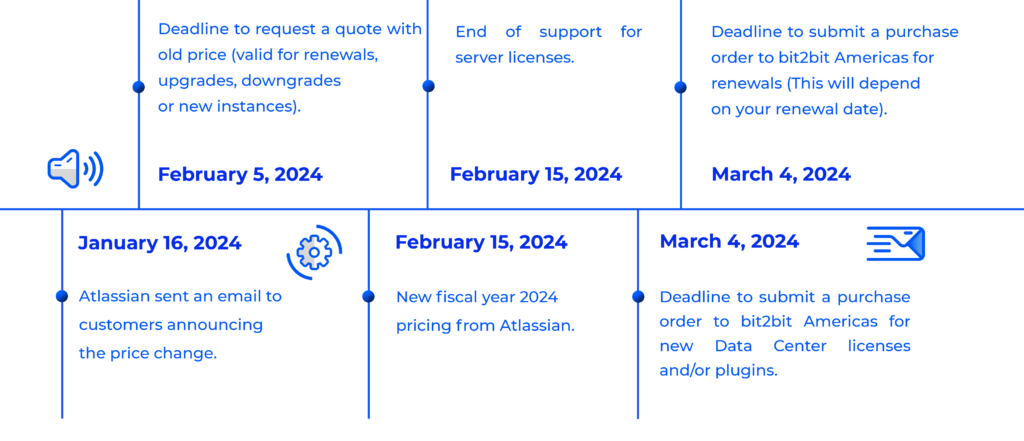News
Important pricing updates for Atlassian Data Center
Last Tuesday, January 16, Atlassian announced a price increase in its Data Center licenses. This change is due to constant improvements in tools, updates and security patches, among other maintenance. Learn more about important dates, the new pricing and our recommendations below.
You can find the official announcement here. At bit2bit Americas we want you to be aware of these changes and we are ready to help you, count on us!
Get to know the most important dates for 2024

Important changes on February 15th, 2024:
February 15th, 2024 PT (Pacific Time):
- Price increase for Data Center goes into effect
- End-of-life of Atlasian Server products comes into effect
Which Atlassian products will be affected and how will prices increase?
Applicable to the following products:
Data Center
Advantaged price:
- Jira Software: All user ranges
- Confluence: All user ranges
Notes
- This price increase only applies to some Atlassian brand products.
- Atlassian introduced some customers to an advantaged plan, which are prices below the currently published list prices that will gradually increase to the list price.
- You can find the table with the price increase by product in the next links:
- The increase applies to Data Center edition products.
- Apps (plugins) from the Marketplace of other manufacturers are not included and are subject to the conditions of each manufacturer.
Recommendations
In this context, bit2bit Americas has the following recommendations for you and your team:
If you have products with an upcoming renewal date in Data Center
- Renew as soon as possible to take advantage of current prices before they change. Take into account that you have to request the quote from bit2bit Americas until February 5th, 2024.
If you plan to upgrade or downgrade in Data Center in the next months
- The quote must be requested from bit2bit Americas until February 5th, 2024.
If you have a Data Center license and want to explore a migration to the Cloud
- Contact us to guide you in your evaluation!
Do not hesitate to contact us and we will be happy to schedule a call in the following weeks to answer all your queries. You can write to us at: team_ventas@bit2bitamericas.com.
Important links
Find other links that might help you:
- Frequently Asked Questions: FAQ Data Center
- Roadmap to Cloud: Roadmap
- Atlassian Data Center product investments: Data Center product investments

Share this:
Related news
News
Important pricing updates for Atlassian Data Center. Last Tuesday, January 16, Atlassian announced a price increase in its...
News
Power, improve and monitor your company's IT services. Learn more about the Atlassian ITSM solutions we have at bit2bit Americas.



